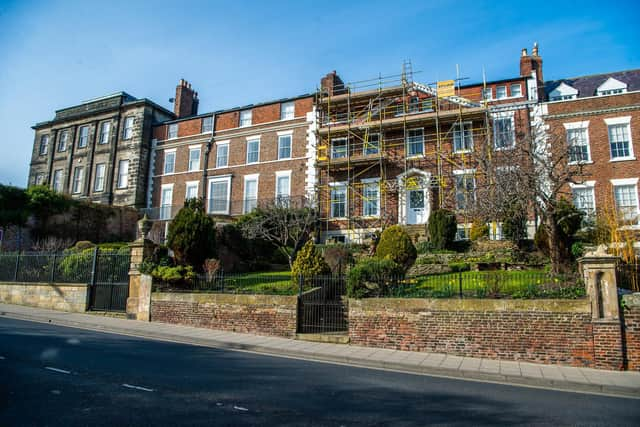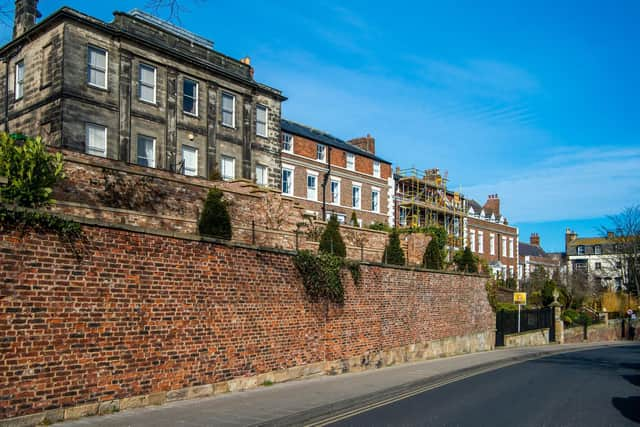St Hilda's Terrace: The story of Whitby's most fascinating street - home to ship owners, whalers and Heartbeat
Built in the 1700s on pasture land that had been owned by the Hayes family for centuries, it quickly became the burgeoning whaling port of Whitby's most desirable address and has always had a strong connection to the sea.
In its early years it was the main residence of ship owners, while their vessels' captains lived closer to the harbour on Esk Terrace. The whole street was Grade II-listed by 1954, so it largely avoided post-war decay as the Regency townhouses could not be converted or subdivided into small flats or bedsits.
Advertisement
Hide AdAdvertisement
Hide AdTen years ago Whitby Civic Society secretary Janet Kukk moved into a property on St Hilda's, and she was immediately captivated by her new surroundings. In the past decade she has researched an entire timeline of ownership of the terrace, consulting sources as eclectic as council bin records to fill in the gaps.


"St Hilda's Terrace has never risen and fallen - it has always been the best road. The houses were built for gentlemen, and most had appendages at the back that they would use as their offices to run businesses from.
"It was a prestigious location and we have three blue plaques here. It was even used for the filming of Heartbeat - one of the houses became a bank.
"Families had the houses built bespoke. Numbers 1-10 were examples of a very early off-plan development, but the buyers would then fiddle with the designs. The staircases would have been identical originally."


Advertisement
Hide AdAdvertisement
Hide AdThe maritime link was there from the start, as one of the many Thomas Hayeses from the landowning family who sold the plots was, according to Janet, 'a bit of a pirate' who was once punished by having his ear cut off for forging a sailor's documents.
Early residents included William Scoresby, who had made a fortune from the Arctic whaling trade, and William Skinner, a ship owner who later entered banking.
"All of the early owners were ship owners and very well-off. One family, the three Harrison brothers, bought several plots. There was also a religious divide; the top end of the terrace was mainly Wesleyan Methodists and the bottom end Quakers. They didn't seem to intermingle much."
In the Georgian era, as was common, the houses were mainly acquired as assets and leased out to tenants, and many passed down generations, but by the 19th century owner-occupiers were becoming more common.
Advertisement
Hide AdAdvertisement
Hide AdThe demographics also changed slightly in the later Victorian period as whaling declined, with professional men moving in.
"By the later 1900s there were a lot of doctors - it was like a small Harley Street and they would have their surgeries at the back, There were several estate managers too."
Janet was particularly intrigued by the houses' functions during both world wars. In the First, Whitby was shelled from the sea during a German bombardment, and the proximity to enemy shipping is likely to have made residents nervous. During World War Two, she has discovered that several of the properties were requisitioned by the military as either billets or training establishments, including her own. She found this out by consulting local records on bins allocated to each address - but it proved difficult to discover more about the war years.
Before the 1954 listing, many of the houses had already been converted into apartments as they had become too big for many families to maintain. However, in the past decade there has been a trend back towards owner occupation.
Advertisement
Hide AdAdvertisement
Hide Ad"The bottom end is still mainly families, and there are more being taken off the holiday let market now, which has been nice to see. But there has never been any trouble with the rented apartments and the gardens are always looked after."
The only blip on the fine architecture of St Hilda's is number 15, which last year was added to Historic England's Heritage At Risk register at the Civic Society's request. Empty and dilapidated, its owner has struggled to fund repairs and it is hoped that the listing will enable him to access financial assistance to return the house to glory.
Numbers 15 and 16 were once one property, but had been divided by 1797. The Middleton family owned 15 for more than 100 years, finally selling up in 1901.
Its last known occupant researched before the 1921 census was made available online was a Captain John Foster, but after his death in 1911 it was advertised for let.
"This is a treasured terrrace, with its views looking out over the moors. It's sad that number 15 is suffering in the way it is and we hope that now something can be done."
